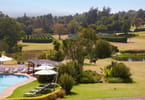Plans by the Namibian Ministry of Environment, Forestry and Tourism (MEFT) to capture and sell off 170 of the last free-roaming elephants among the communal farming areas of north-western and north-eastern Namibia are proving highly contentious and potentially a big blow to an already struggling local tourism industry.
“Regular foreign visitors are following this development very closely and are already threatening with a boycott of Namibian tourism,” which would impact negatively on conservation, said Izak Smit, a noted figure in desert lion conservation.
MEFT last week Wednesday advertised for offers from registered Namibian game capturing firms to capture and remove four lots of 30 to 60 elephants in the Omatjete, Kamanjab, Tsumkwe and Kavango East areas.
“Due to drought and increase in elephant numbers coupled with Human-Elephant conflict incidences, a need has been identified to reduce these populations,” (sic) the ad read.
However, no substantiating evidence backing this claim was provided, with the results of an August 2019 aerial survey of the elephant population in north-eastern yet to be released despite requests.
It appears that the request for tenders is a political decision as local conservationists were caught off guard by the proposals, with no mention of this capture and live sale at a recent meeting to discuss the revision of Namibia’s Elephant Management Plan. Other concrete proposals to mitigate Human Elephant Conflict were however recently agreed with stakeholders, including the provision of elephant water points away from villages, electric fencing and elephant corridors which would obviate any necessity for translocation.
Senior MEFT officials were also not aware of these proposals.
Indications were that the population is in decline, with Namibia suffering a prolonged drought that has decimated game populations and caused sporadic outbreaks of anthrax that has of late caused large die-offs in the Linyanti-Chobe elephant population.
MEFT spokesman Romeo Muyanda confirmed Tuesday that 31 elephant carcasses were found along the Linyanti river .
“We hugely suspect that the elephants might have died of anthrax considering that a week earlier 12 hippos died as a result of anthrax. Samples are been taken to determine the exact cause,” Muyanda said.
At an official elephant workshop held in Windhoek two weeks ago, MEFT’s Pohamba Shifeta also had raised the topic in his opening speech in which he reiterated that Namibia has the right to sell off its estimated 50-ton ivory stockpile. Ivory sales are however presently prohibited under CITES regulations and recent proposals by Namibia to open trade in ivory have been resoundingly defeated.
According to the AfESG African elephant status report of 2016 there were 22 754 elephants in Namibia, The bulk of this population , an estimated 17 265 elephants is in trans-border herds which move between Namibia, Angola, Zambia and Botswana. Director of National Resources Colgar Sikopo previously claimed these transitory animals were not included in the Namibian estimate.
However Namibia refused to participate in the 2015 Great Elephant Census and has declined requests for details of its surveys or methodologies used. There is a wide confidence limit in these population estimates which substantially exceeds the confidence limit of 10% that aerial surveyors normally aim for, so it is questionable if the Namibian aerial survey design is providing accurate estimates of highly mobile elephant populations which move between four countries.
Ninety of the 170 elephants are to be captured in the communal areas bordering the unfenced Khaudom National Park and its estimated population of 3 000 elephants.
These areas are former San ancestral lands, with the Kavango East carved up into about 500 leasehold farms of 2 500 hectares each that were allocated to the local political elite since 2005. Large-scale, uncontrolled logging by Chinese timber speculators here has since 2017 all but wiped out the slow-growing African rosewood (Guiberto coleosperma).
The other 80 are to be captured in the commercial and communal farming areas south-west of the Etosha National Park where two herds are known to keep, the smaller one of 30 occasionally venturing as far south as Omatjete (300 km north-east of the capital Windhoek).
Whether capturing these elephants will be at all economically or physically feasible is extremely doubtful, due to their wide dispersal over often inaccessible terrain. The north-western herds tended to be widely dispersed over a vast, rough rock desert, while the Kavango East-Tsumkwe area is even larger and located in deep Kalahari Sand overgrown with a heavy tree canopy.
The MEFT tender, which is restricted to Namibian-registered game capturing outfits and closes on January 29, calls for the complete removal of all elephants, including the often solitary bulls, from these areas. All costs and risks are to be borne by the game capturing company.
The tender could be an attempt to retain the rural vote after SWAPO’s poor showing in the recent local government elections with the strongest lobby behind the plan being the small-scale commercial farmers of Kavango East and the larger commercial farmers of Kunene and Erongo,
The tender appeared aimed at the export market, with the specifications calling would-be exporters to ensure that the country of destination will permit their import in accordance with CITES regulations.
It appears unlikely that anyone in Namibia wants more elephants, but there is one lucrative export market: the Democratic Republic of the Congo and its former President Joseph Kabila, who has built up a large private game reserve east of Kinshasa. Since 2017, hundreds of plains game – including zebra, kudu, oryx and giraffes – have been exported to the DRC.
This might comply with CITES regulations which only allow live export of elephants to“appropriate and acceptable destinations ” which are defined as “in situ conservation programmes or secure areas in the wild within the species’ natural and historical range in Africa””.
Only time will reveal the future of these elephants should the contentious relocations not materialize, with poaching and hunting under Damage Causing Animal permits an ever present threat.
By: John Grobler
WHAT TO TAKE AWAY FROM THIS ARTICLE:
- The other 80 are to be captured in the commercial and communal farming areas south-west of the Etosha National Park where two herds are known to keep, the smaller one of 30 occasionally venturing as far south as Omatjete (300 km north-east of the capital Windhoek).
- Plans by the Namibian Ministry of Environment, Forestry and Tourism (MEFT) to capture and sell off 170 of the last free-roaming elephants among the communal farming areas of north-western and north-eastern Namibia are proving highly contentious and potentially a big blow to an already struggling local tourism industry.
- At an official elephant workshop held in Windhoek two weeks ago, MEFT’s Pohamba Shifeta also had raised the topic in his opening speech in which he reiterated that Namibia has the right to sell off its estimated 50-ton ivory stockpile.






















